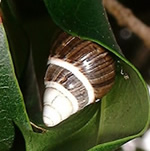|
Achatinella mustelina
Achatinella mustelina is a species of air-breathing land snail, a terrestrial pulmonate gastropod mollusc in the family Achatinellidae. This species is endemic to the Waianae Range of the island of Oahu, Hawaii.  All 13 subspecies of Achatinella mustelina were synonymized with the species by Holland & Hadfield (2007),[3] because they are not monophyletic.[3] HabitatAchatinella mustelina can be found on elevated forests that are dry, wet, or mesic. Achatinella mustelina attaches itself to leaves at the tops of native trees and shrubs such as Metrosideros polymorpha, Dubautia plantanginea, Myrsine lessertiana, Pisonia sandwicensis, Antidesma platyphyllum and Nestegis sandwicensis. Some individuals may live on a single tree for their entire lifetime. Range Elevation: 600 to 1,158 m (1,970 to 3,800 ft)[4] Physical DescriptionAchatinella mustelina from different locations vary in size, shape, and color. Adults range from 19 to 24 mm (0.75 to 0.94 in) in length, with an average length of 21.4 mm (0.84 in). The shells have a shiny finish and are usually brown with light bands that circle the suture convex, or they are white with transverse black or brown lines.[5] DietAchatinella mustelina feeds primarily at night. Both adults and juveniles graze on fungus on surface of leaves at night.[6] LifespanAchatinella mustelina has long lifespan compared to other terrestrial gastropods. Longetivity is estimated to be 10 years, but individuals may live up to 15 to 20 years.[7] ReproductionAchatinella mustelina is hermaphroditic and may self-fertilize. They have a lengthy gestation period and give birth to large, live young that mature late and have a low fecundity. Achatinella mustelina breeds year-round.[6] DevelopmentAchatinella mustelina develop from an intrauterine embryo. Growth in utero is thought to be logarithmic[8] References
External links
Information related to Achatinella mustelina |
||||||||||||||||||||||||||||||||||

